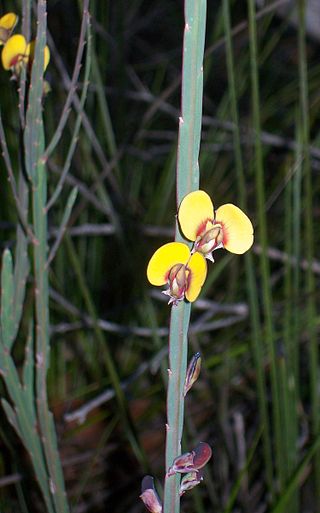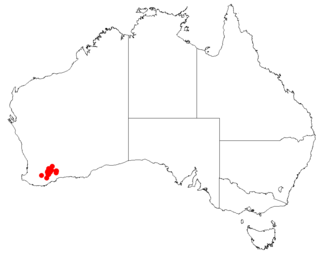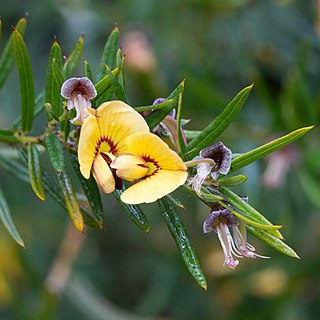
Bossiaea buxifolia, commonly known as matted bossiaea, is a species of flowering plant in the family Fabaceae and is endemic to south-eastern Australia. It is a prostrate to weakly erect shrub with elliptic to egg-shaped or almost round leaves and yellow, red and purplish flowers.

Bossiaea scolopendria, commonly known as plank plant, is a species of flowering plant in the family Fabaceae and is endemic to New South Wales. It is an erect, sparsely-branched shrub with flattened branches, ending in winged cladodes, the leaves mostly reduced to small scales except on the youngest branches, and yellow and red flowers.
Bossiaea vombata, commonly known as wombat bossiaea, is a species of flowering plant in the family Fabaceae and is endemic to the Wombat State Forest in Victoria, Australia. It is an erect shrub with flattened cladodes and yellow, pea-like flowers.
Bossiaea nummularia is a species of flowering plant in the family Fabaceae and is endemic to New South Wales. It is a prostrate to low-lying sub-shrub with moderately hairy foliage, mostly broadly elliptic leaves, and yellow and red flowers.
Bossiaea bracteosa, commonly known as mountain leafless bossiaea, is a species of flowering plant in the family Fabaceae and is endemic to north-eastern Victoria, Australia. It is a dense shrub that often forms root suckers and has winged branches, winged and lobed cladodes, leaves reduced to small scales, and deep yellow flowers, often with red blotches.

Bossiaea stephensonii is a species of flowering plant in the family Fabaceae and is endemic to near-coastal areas of New South Wales. It is a small, weakly erect, multi-stemmed shrub with sharply-pointed, mostly elliptic to egg-shaped leaves, and bright yellow and red flowers.

Bossiaea tasmanica is a species of flowering plant in the family Fabaceae and is endemic to Tasmania. It is a prostrate or low-lying shrub with spiny branches, elliptic to egg-shaped with the narrower end towards the base, and yellow and red to pink flowers.

Bossiaea halophila is a species of flowering plant in the family Fabaceae and is endemic to Western Australia. It is a dense, erect, many-branched shrub with narrow-winged cladodes, leaves reduced to small scales, and yellow-orange and deep red flowers.

Bossiaea carinalis is a species of flowering plant in the family Fabaceae and is endemic to eastern Queensland. It is an erect shrub with narrow egg-shaped to lance-shaped leaves and pink to red and yellow flowers.

Pultenaea fragrans is a species of flowering plant in the family Fabaceae and is endemic to a small area of New South Wales. It is an erect shrub with flattened cladodes, small, scale-like leaves, and pea-like, yellow and red flowers.

Pultenaea grayi, commonly known as Murrumbidgee bossiaea, is a species of flowering plant in the family Fabaceae and is endemic to the Australian Capital Territory. It is an erect shrub with flattened, winged, glabrous cladodes, leaves reduced to small scales, and pea-like, yellow and red flowers.
Bossiaea milesiae is a species of flowering plant in the family Fabaceae and is endemic to a restricted area of New South Wales. It is an erect shrub with flattened, winged cladodes, small, scale-like leaves, and pea-like yellow to apricot-coloured and red flowers.

Bossiaea neoanglica is a species of flowering plant in the family Fabaceae and is endemic to eastern Australia. It is a prostrate to low-lying shrub with sparsely hairy foliage, egg-shaped to more or less round leaves, and yellow and red flowers.
Bossiaea obovata is a species of flowering plant in the family Fabaceae and is endemic to eastern Australia. It is a small, low-lying or prostrate shrub with egg-shaped leaves with the narrower end towards the base, and pea-shaped, yellow and red flowers.
Bossiaea oligosperma, commonly known as few-seeded bossiaea, is a species of flowering plant in the family Fabaceae and is endemic to eastern New South Wales. It is an erect shrub with broadly egg-shaped to more or less round leaves with a small point on the tip, and yellow and red flowers.
Bossiaea peninsularis is a species of flowering plant in the family Fabaceae and is endemic to the Eyre Peninsula in South Australia. It is an erect rhizome-forming, more or less leafless shrub with leaves reduced to small scales, and yellow, red and purplish flowers.
Bossiaea praetermissa is a species of flowering plant in the family Fabaceae and is endemic to near-coastal areas in the far south-west of Western Australia. It is a shrub with many flattened, winged cladodes and deep yellow and reddish or maroon flowers.

Bossiaea riparia, commonly known as river leafless bossiaea, is a species of flowering plant in the family Fabaceae and is endemic to south-eastern Australia. It is an erect or low-lying shrub with flattened branches, linear young cladodes, leaves mostly reduced to small scales, and yellow and red flowers.

Bossiaea rosmarinifolia, commonly known as Grampians bossiaea, is a species of flowering plant in the family Fabaceae and is endemic to the Grampians in Victoria. It is an erect or spreading shrub with linear leaves and yellow and red flowers.

Bossiaea scortechinii is a species of flowering plant in the family Fabaceae and is endemic to eastern Australia. It is a prostrate to low-lying shrub with simple, elliptic to egg-shaped leaves with the narrower end towards the base, and orange-yellow flowers with red to pinkish markings.












